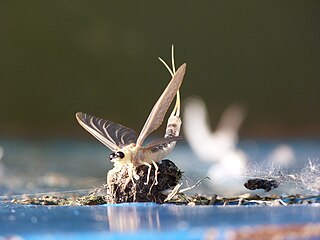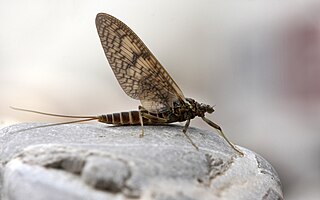
Mayflies are aquatic insects belonging to the order Ephemeroptera. This order is part of an ancient group of insects termed the Palaeoptera, which also contains dragonflies and damselflies. Over 3,000 species of mayfly are known worldwide, grouped into over 400 genera in 42 families.

Ephemera danica, the green drake or green drake mayfly, is a species of mayfly in the genus Ephemera.

Baetis is a genus of mayflies of the family Baetidae, known as the blue-winged olive to anglers. There are at least 150 described species in Baetis. They are distributed worldwide, with the most variety in North America and northern Europe.

Rhithrogena is a genus of flatheaded mayflies in the family Heptageniidae. There are at least 150 described species in Rhithrogena.

Palingenia longicauda is an aquatic insect in the order Ephemeroptera. It is known as the Tisa or Tisza mayfly after the European Tisza river where it is found and also as the long-tailed mayfly and giant mayfly since it is the largest mayfly species in Europe, measuring 12 cm (4.7 in) from head to tail.

Rhithrogena germanica is a European species of mayfly, and is "probably the most famous of all British mayflies", because of its use in fly fishing. It is known in the British Isles as the March brown mayfly, a name which is used in the United States for a different species, Rhithrogena morrisoni. It emerges as a subimago at the end of winter, and can be distinguished from similar species by a dark spot on the femur of each leg.
In the 10th edition of Systema Naturae, Carl Linnaeus classified the arthropods, including insects, arachnids and crustaceans, among his class "Insecta". Insects with net-veined wings were brought together under the name Neuroptera.
Neoephemera is a genus of large squaregill mayflies in the family Neoephemeridae. There are about six described species in Neoephemera.

Ephemera vulgata is a species of mayfly in the genus Ephemera. This mayfly breeds in stationary water in slow rivers and in ponds, the nymphs developing in the mud.

Baetiscidae is a family of armored mayflies in the order Ephemeroptera. There are at least 2 genera and about 12 described species in Baetiscidae.
Potamanthus yunnanensis is a species of hacklegilled burrower mayfly in the family Potamanthidae.
Potamanthus idiocerus is a species of hacklegilled burrower mayfly in the family Potamanthidae.

Potamanthus luteus is a species of hacklegilled burrower mayfly in the family Potamanthidae.
Drunella spinifera is a species of spiny crawler mayfly in the family Ephemerellidae. It is found in southwestern and northern Canada and the western United States and Alaska.

Ameletus cryptostimulus is a species of combmouthed minnow mayfly in the family Ameletidae. It is found in southeastern Canada and the eastern United States.

Epeorus vitreus is a species of flatheaded mayfly in the family Heptageniidae. It is found in southeastern Canada and the eastern United States.
Gratia is a genus of small minnow mayflies in the family Baetidae. There are at least two described species in Gratia.
Iswaeon is a genus of small minnow mayflies in the family Baetidae. There are at least three described species in Iswaeon.












